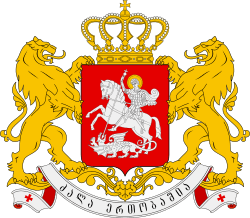Dmanisi

Dmanisi (Georgian: დმანისი) is a townlet and archaeological site in the Kvemo Kartli region of Georgia approximately 93 km southwest of the nation’s capital Tbilisi in the river valley of Mashavera. The hominin site is the earliest of its kind outside of Africa, dating back to 1.81 Ma.[1][2]
A series of skulls from Dmanisi, discovered in the early 2010s, led to the hypothesis that many separate species in the Homo genus were in fact a single lineage.[3] Also known as Skull 5, the Dmanisi human skull is the fifth skull to be discovered in Dmanisi.
History
The town of Dmanisi is first mentioned in the 9th century as a possession of the Arab emirate of Tbilisi, though the area had been settled since the Early Bronze Age. An Orthodox Christian cathedral – “Dmansis Sioni” – was built there in the 6th century. Located on the confluence of trading routes and cultural influences, Dmanisi was of particular importance, growing into a major commercial center of medieval Georgia. The town was conquered by the Seljuk Turks in the 1080s, but was later liberated by the Georgian kings David the Builder and Demetrios I between 1123 and 1125. The Turco-Mongol armies under Timur laid waste to the town in the 14th century. Sacked again by the Turkomans in 1486, Dmanisi never recovered and declined to a scarcely inhabited village by the 18th century. The castle was controlled by the House of Orbeliani.
Archaeological site

Extensive archaeological studies began in the area in 1936 and continued in the 1960s. Beyond a rich collection of ancient and medieval artifacts and the ruins of various buildings and structures, unique remains of prehistoric animals and humans have been unearthed. Some of the animal bones were identified by the Georgian paleontologist A. Vekua with the teeth of the extinct rhino Dicerorhinus etruscus etruscus in 1983. This species dates back presumably to the early Pleistocene epoch.
The discovery of primitive stone tools in 1984 led to increasing interest to the archaeological site. In 1991, a team of Georgian scholars was joined by the German archaeologists from Römisch-Germanisches Zentralmuseum, and later the U.S., French and Spanish researchers.
Homo erectus georgicus
Early human (or hominin) fossils, originally named Homo georgicus and now considered Homo erectus georgicus, were found at Dmanisi between 1991 and 2005. At 1.8 million years old, they are now believed to be a subspecies of Homo erectus and not a separate species of Homo. These fossils represent the earliest known human presence in the Caucasus.
Subsequently, four fossil skeletons were found, showing a species primitive in its skull and upper body but with relatively advanced spines and lower limbs. They are now thought to represent a stage soon after the transition from Australopithecus to Homo erectus.
Human habitation in the Caucasus goes back to the remotest antiquity. The hominin remains discovered in 1991 by David Lordkipanidze at Dmanisi, Kvemo Kartli (1.8 million years old) are the oldest found outside of Africa.[4] Neanderthal remains have been found at Ortvale K’lde (1973) and elsewhere in the Caucasus (36,000–50,000 years old).
The Dmanisi hominin remains are still making an impact on the paleontological community. As of 2014 the Dmanisi skull 5 is in the middle of a controversy: many hominin fossils formerly thought to be different species may not have been separate species at all. Several early members of the genus Homo were possibly one evolving lineage.[5]
See also
References
- ↑ Garcia, T., Féraud, G., Falguères, C., de Lumley, H., Perrenoud, C., & Lordkipanidze, D. (2010). “Earliest human remains in Eurasia: New 40Ar/39Ar dating of the Dmanisi hominid-bearing levels, Georgia”. Quaternary Geochronology, 5(4), 443–451. doi:10.1016/j.quageo.2009.09.012
- ↑ Gabunia, Leo; Vekua, Abesalom; Lordkipanidze, David et al. "Earliest Pleistocene Hominid Cranial Remains from Dmanisi, Republic of Georgia: Taxonomy, Geological Setting, and Age". Science 12 May 2000: Vol. 288 no. 5468 pp. 1019–1025. DOI: 10.1126/science.288.5468.1019.
- ↑ New Fossil May Trim Branches of Human Evolution, Science Friday, Oct 18, 2013.
- ↑ (Zatiashvili, 2008)
- ↑ Skull suggests three early human species were one : Nature News & Comment
External links
- Dmanisi archaeological site
- Kalmakoff, Jonathan J. Doukhobor Genealogy Website
- Foley, Jim (13 January 2009). "Skull D2700". TalkOrigins Archive. Retrieved 9 September 2009.
- Connor, Steve (9 September 2009). "A skull that rewrites the history of man". The Independent. Retrieved 9 September 2009.
Coordinates: 41°19′N 44°21′E / 41.317°N 44.350°E

